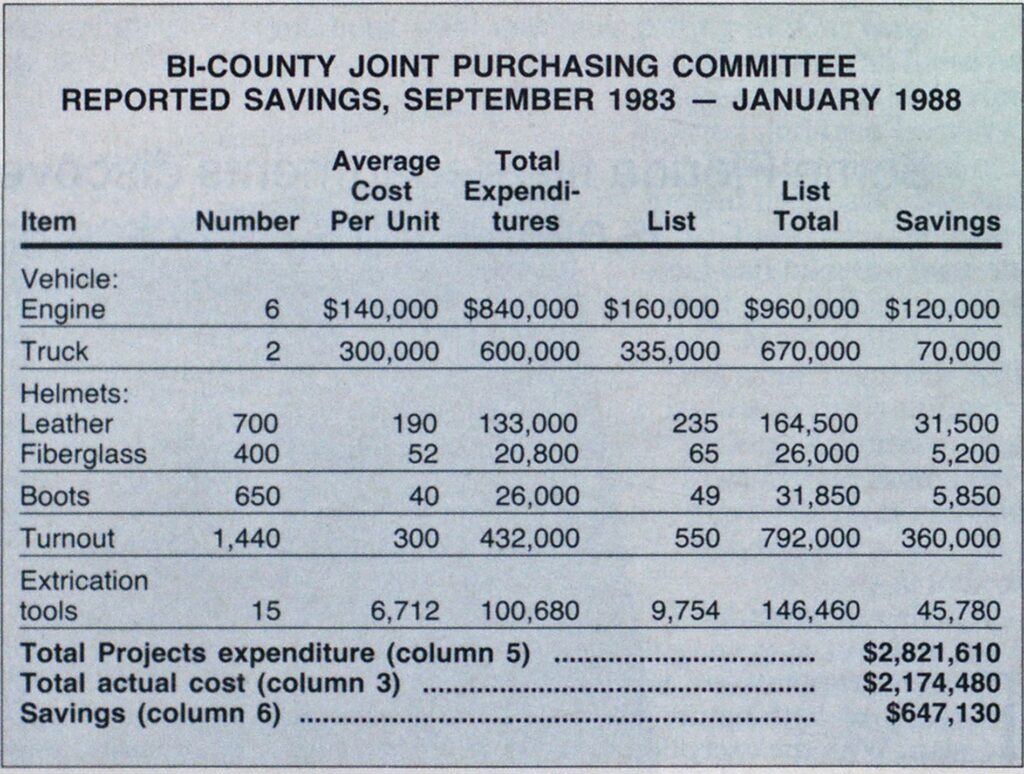
Joint Purchasing Group
FEATURES
MANAGEMENT
Some Florida fire departments discover that cooperation is everything it’s cracked up to be.
Fire departments are territorial beasts by both nature and design. With the exception of disasters and mutual aid agreements, most focus their efforts on their own service area.
But on September 19, 1983, a historic event occurred in Broward County, Florida. After years of jurisdictional and territorial protectionism, 13 fire departments decided to ignore past prejudices and formed the Bi-County Joint Purchasing Committee. Today, this purchasing consortium has doubled in size and has realized about $647,130 in savings.
The idea for a joint purchasing committee developed when the City of Deerfield Beach Fire/Rescue Department was shopping for a medical/rescue unit. Shocked at the prices being quoted and realizing that area departments purchased nearly the same equipment, Chief Tom Boylston and senior officers decided that joint purchasing was worth a try.
Letters explaining what the committee wanted to accomplish were sent to all municipalities, fire departments, and EMS providers in Broward and Palm Beach counties. The initial response was moderate; nevertheless, meetings were scheduled for the first Friday of each month.
Some traditional barriers were still evident at the first meeting, but patience and cooperation persisted.
The first step was to get purchasing help and assurance that the committee wasn’t breaking any of the towns’ purchasing ordinances. Fortunately, that wasn’t the case, and the City of Fort Lauderdale Fire Department volunteered its city’s purchasing division to advertise and take care of all the legal requirements. This was a quantum jump towards cooperation and teamwork.
Turnout clothing was the committee’s first attempt at collective purchasing. Research was conducted: We reviewed specifications on the member departments’ existing protective clothing and talked to union representatives about what they’d be looking for in clothing requirements. Next, manufacturers were contacted, and a set of specifications was developed. A bid was awarded for 700 sets of turnout gear at a cost of $286 a suit. Each city cut its own purchasing order for the quantity its department needed, and the gear was shipped directly to the department. According to the manufacturer, $167,300 was saved.
The success of this initial venture got the attention of nonparticipating organizations; 10 more departments became members. One new member, the Boca Raton Fire Department, was in another county. The news about collective purchasing was not only crossing jurisdictional boundaries, but county boundaries as well. The committee was now 23 members strong.
It was decided that members could opt not to purchase what the committee had decided to bid on. This “escape clause” allows the committee to smooth over some of the difficulties involved in dealing with 23 organizations. The collective purchase of turnout gear, boots, gloves, and extrication equipment during the committee’s first year saved $202,800 of taxpayers’ money. The government bodies and news media became highly supportive of the concept.

The first major stumbling block came when the committee was split over what type of helmet to buy. Rather than allow this to be its downfall, the committee bid two styles, one a leather model and one a fiberglass composite. More than 700 leather and 400 fiberglass helmets were purchased at a combined savings of $31,500.
With savings approaching $250,000 in little more than a year’s time, the committee decided to attack the “sacred traditional” area of apparatus.
Division Chief Peter Tritch of the City of Pembroke Pines Fire Department headed a comprehensive, four-month project devoted to developing specifications for a 1,250-gpm pumper and an aerial truck. The bid was awarded to a Florida manufacturer for six engines and two aerial trucks. Depending on if the organization chose an equipped vehicle or the vehicle alone, the savings was approximately $3050,000 per vehicle. The savings passed on to the taxpayer approaches $190,000.
The committee’s success sometimes becomes evident in surprising ways. It recently bid on turnout gear for the third time, only to find that the low bid was $3 less per suit than the original bid two years prior. The strength of the committee is apparent when manufacturers take bare-bones profits just to get the committee’s business, as was the case here.
Flowever, not everyone is pleased with the committee’s efforts, namely, some salespeople and middlemen. They’ve complained because some of the bids are so large that the manufacturers are bidding direct. Another blow for some is that the “good ole boy” system is no longer in effect. A company’s product must sell on its merit and price, not on past friendships. Yet, other salespeople have expressed gratitude for the formation of the Bi-County Joint Purchasing Committee. They like the idea of going directly to the committee at its regular monthly meeting and getting their product seen by 25 different departments.
Changing the way our local departments purchase some of tneir equipment hasn’t always been easy, but it’s been worth the time and effort. Each committee member is to be commended for his or her patience and expertise. The individual governmental agencies that allowed their departments to explore new avenues of cost-effective operation are also to be applauded. And the people who feel that they’re the big winners are the taxpayers. The committee’s experiment is a triumph for all.


